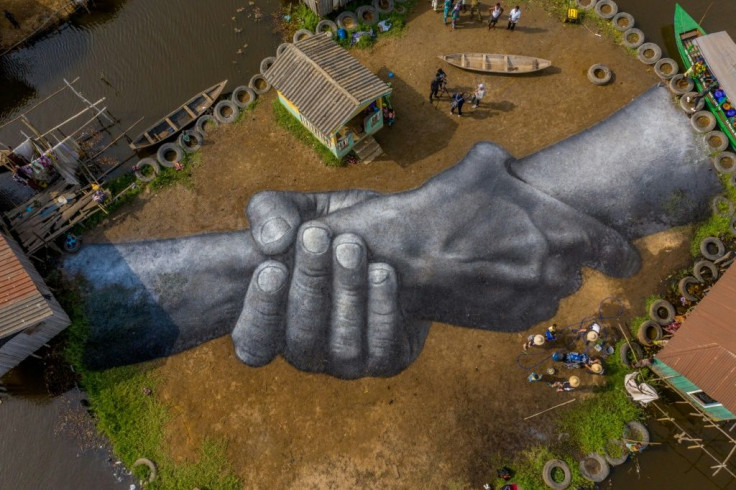Giant Fresco Appears In Floating Benin Village
On a small island surrounded by hundreds of wooden huts on stilts, in the middle of Lake Nokoue in southeast Benin, a giant painting is taking shape.

For the past three hours, in 41 degrees Celsius (106F) heat, French artist Saype has been busy transforming a playground in the floating village of Ganvie.
Shapes gradually appear on the grass in grey and black paint from the nozzle of his sprayer.

Fishermen, women selling fish, and children from the village are gathered around him, observing the scene with wonder as a drone hovers above their heads.
"No one knows yet what this man is doing," resident Sonagnon Dagbedji says, his eyes fixed on Saype.

The 33-year-old says he's seen paintings before in a local gallery, "but painting on the grass? That's a first."
It's not just the art attracting curious residents -- the artist himself intrigues many.

"Seeing a white man coming to Ganvie to paint, that's an event in itself," said another resident, Sokin Agodokpedji.
"We were told the final result would be special so we are waiting," said the eager 25-year-old fisherman.
At last, the fresco is ready. Onlookers congregate to watch a video from the drone's camera on a small screen.
The strokes of paint have formed into two giant interlaced hands.
For Saype, whose real name is Guillaume Legros, this painting is part of "the largest human chain in the world."
The "Beyond Walls" project started in Paris in front of the Eiffel Tower and has over several years travelled around the world, reaching Andorra, Berlin, Geneva, Ouagadougou, Yamoussoukro, Turin, Istanbul and Cape Town before coming to Benin's floating village of Ganvie.
"We are at a point in history where the world is polarising, and where a part of people are more and more turning in on themselves," Saype wrote in a presentation on the project.
The interlaced hands are "a symbol of kindness and goodwill between people," he says, "to try and build bridges."
© Copyright AFP {{Year}}. All rights reserved.




















